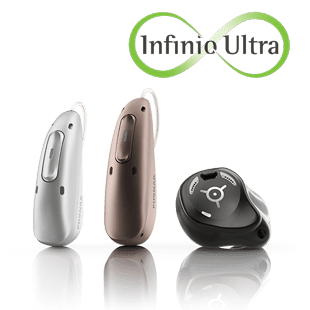
Optimizing hearing aid fittings for older adults: Addressing both auditory and cognitive changes
To help older adults be successful with hearing technologies, clinicians should consider age-related auditory processing and cognitive changes. This article outlines practical fitting strategies and Phonak technologies that help reduce listening effort and support everyday communication.
As the global population ages, clinicians are increasingly faced with the challenge of supporting older adults experiencing changes in both hearing and cognition.
A recent review by Windle et al. (2023), highlights the need to tailor hearing aid fittings to reflect these dual changes and outlines practical, evidence-based strategies for positive outcomes.¹
How aging affects hearing and cognition
While age-related hearing loss is well documented, it is equally important for clinicians to consider the gradual cognitive changes that affect speech understanding—particularly in noisy or complex listening environments.
Reduced neural connectivity, slower processing speed, and limited working memory all contribute to greater difficulty understanding speech and increased listening effort. Reduced temporal processing (the brain’s ability to track timing cues in speech) further affects the listener’s ability to extract key speech cues from background noise.
These auditory challenges are compounded by increased cognitive load (the mental effort required to process and make sense of auditory input), which further limits the listener’s ability to focus, filter out distractions, and retain information in conversation.
Listening effort and its impact on older adults
Listening effort—the cognitive energy required to make sense of sound—often increases with age, particularly for those with hearing loss. This can lead to fatigue, frustration, and reduced hearing aid use. Listening effort is a key consideration for achieving successful hearing aid use and benefit.
Evidence-based fitting strategies
In their 2023 review, Windle and colleagues propose hearing aid fitting strategies aimed at reducing listening effort in older adults by mitigating cognitive load and auditory distortion. Strategies outlined in the review include:
- Preserve speech envelope and binaural cues
Slow-acting compression preserves the natural rhythm and clarity of speech, which is important for comprehension. Maintaining binaural cues supports sound localization and speech understanding in noise. Windle et al. emphasize the importance of avoiding settings that distort speech cues, particularly for older listeners. - Use directional and remote microphone technologies
Directional microphones and remote microphone systems enhance the signal-to-noise ratio (SNR), making it easier to focus on conversations in noisy settings. Windle et al. discuss the importance of improving SNR and reducing listening effort. - Apply moderate noise reduction
Moderate noise reduction is generally preferred, though there are individual differences. It improves listening comfort without interfering with speech intelligibility. - Validate fittings with REM and client feedback
Real ear measurements (REM) ensure that the hearing aid’s output matches the prescribed amplification. Gathering feedback from older adults ensures the fitting aligns with their comfort and communication needs, which is especially important as aging may impact their ability to adapt to amplification changes.
Together, these strategies offer a practical framework for tailoring hearing aid fittings to the combined auditory and cognitive needs of older adults —particularly those showing signs of cognitive decline due to aging or underlying conditions.
Phonak technologies that support these best practices
Phonak hearing aids, including those powered by Lumity and Infinio platforms, integrate features designed to support these evidence-based approaches. These include:
- Adaptive Phonak Digital (APD) 3.0: Combines fast and slow compression to maintain listening comfort while preserving important speech cues.
- StereoZoom 2.0: Provides 3dB better SNR when speech is coming from the front at maximum strength, and an additional 2.5dB SNR in noisy listening environments.2
- Speech Enhancer: Shown to reduce listening effort for soft speech in quiet and is also preferred for hearing at a distance.3
- Spheric Speech Clarity: Wearers with moderate to moderately-severe hearing loss are 2 times more likely to understand speech from any direction with Spheric Speech Clarity compared to without.4
- Roger™ remote microphones: Deliver the speaker’s voice directly to the hearing aids, improving understanding in group settings, at a distance, or in background noise5—common challenges for older listeners.
By integrating clinical best practices with advanced hearing technology, clinicians can better support the unique needs of older adults. This holistic approach may help reduce listening effort, improve hearing aid satisfaction, and support more meaningful communication in daily life.
Want to learn more?
Download the PDF of the Phonak Insight here. You can also find this document and other peer-reviewed research in the Phonak Evidence Library.
Learn how Phonak technologies support these best practices by visiting our product pages.
References:
- Windle, R., Dillon, H., & Heinrich, A. (2023). A review of auditory processing and cognitive change during normal ageing, and the implications for setting hearing aids for older adults. Frontiers in Neurology, 14, 1122420.
- Appleton, J. (2020). AutoSense OS 4.0 – significantly less listening effort and preferred for speech intelligibility. Phonak Field Study News, retrieved from www.phonak.com/evidence.
- Latzel, M, Heeren, J and Lesimple, C. (2024). Speech Enhancer reduces listening effort and fatigue. Phonak Field Study News, retrieved from www.phonak.com/evidence.
- Wright, A., Kuehnel, V., Keller, M., Seitz-Paquette, K., Latzel, M. (2024). Spheric Speech Clarity applies DNN signal processing to significantly improve speech understanding from any direction and reduce the listening effort. Phonak Field Study News, retrieved from https://www.phonak.com/evidence.
- Thibodeau L. M. (2020). Benefits in speech recognition in noise with remote wireless microphones in group settings. Journal of the American Academy of Audiology, 31(6), 404–411.
